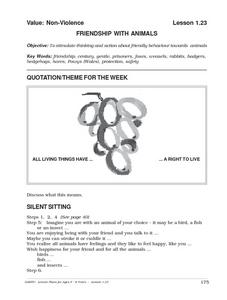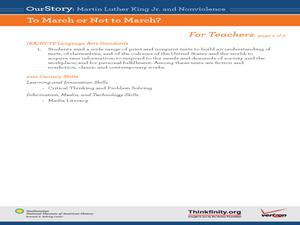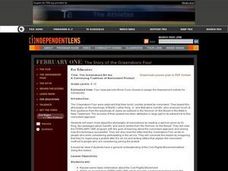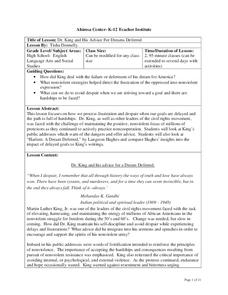Described and Captioned Media Program
Malcolm X: Make It Plain, Part II
Track the transformation of Malcolm Little into Malcolm X and then into El Jajj Malik El-Shabazz with the second part of Make it Plain, a documentary on the famous civil rights activist. Viewers consider not only how events shaped and...
Curated OER
Value: Non-Violence - Friendship With Animals
Young scholars discuss the importance of respecting animals and properly providing for their needs. In a class setting, students read a story about animals and identify kind and caring actions toward the animals. After a class...
Curated OER
The Popular Bully
Fifth graders investigate bullying and nonviolent ways to deal with bullies. In this conflict management lesson, 5th graders discover the definition for the word ahimsa and examine ways to incorporate that philosophy into their social...
Teaching for Change
A Documents-Based Lesson on the Voting Rights Act
How did the Voting Rights Act affect the daily lives of American citizens? A document-based lesson developed by the Student Non-Violent Coordinating committee (SNCC) presents a case study of the impact of the Voting Rights Act of 1965 on...
Curated OER
INTRODUCTORY LESSON for the beginning of each new year
Students study and express the five values of truth, love, peace, right conduct, and non-violence. The lesson focuses on the beginning of the year, introducing the values. Through games, singing, and reading--students become familiar...
Curated OER
Martin Luther King, Jr., and the Power of Nonviolence
Students examine the philosophy of nonviolence developed by Martin Luther King, Jr. and how this turned into practice during the Civil Rights Movement. They compare these teachings to those of Mohandas K. Ghandi.
Curated OER
Creating Nonviolence: A Theatre of the Oppressed Approach to Things Fall Apart
Eleventh graders analyze Ahimsa and complete activities for nonviolence. In this nonviolence lesson, 11th graders define violence and relate it to their lives. Students adapt prose into a dialogue to act out and analyze the violence in...
Curated OER
Gandhi's Alternate View of Women: Changing the Face of Modern Media & Advertising
Eleventh graders analyze the violence of media and advertising on women, as well as Gandhi's views of women. For this women and media lesson, 11th graders Killing Us Softly and Tough Guise as an analysis of media and advertising and...
Curated OER
Nonviolence and Conflict: Its Importance to Building Community
Students study nonviolence and the values associated with nonviolence. In this social science lesson, students identify the six steps of nonviolence and the six principles of nonviolence as put forth by Martin Luther King, Jr. Students...
Curated OER
The Way You Dream: Gandhi and King's Visions of Nonviolence
Learners read Gandhi and Dr. King's messages about nonviolence and discuss their visions about loving one's enemies. In this nonviolence lesson, students read Gandhi's "Ahimsa, or the Way of Nonviolence" and Dr. Martin Luther King's...
Curated OER
The Power of Nonviolent Resistance
Young scholars discuss the power of nonviolent resistance in terms of Dr. Martin Luther King and the boycotts that he led. In this nonviolent resistance lesson plan, students discuss their thoughts of nonviolent resistance and how they...
Curated OER
To March or Not to March?
Students read historical artifacts about the March on Washington for Jobs and Freedom and analyze the choices made during the time. In this March on Washington lesson, students read Martin's Big Words and the 'Step Back in Time' sheets....
Curated OER
Martin Luther King Jr. and Nonviolence
Students explore a local seat of government to examine ways to make changes in their communities. In this local government activity, students read about Martin Luther King, Jr. and his nonviolent protests. Students read important dates...
Gobal Oneness Project
Building a Community of Trust
Barrio de Paz is the story of Nelsa Libertad Curbelo, a nun, who works with the gang youth of Guayaquil, Ecuador. The 17-minute documentary focuses on her explanations for the rise of gangs and for how gang culture reflects societal values.
Curated OER
What is the Role of Civil Disobedience Today?
Students examine the meaning and use of civil disobedience. They decide whether civil disobedience is a viable form of protest in contemporary times after studying the acts of Rosa Parks.
Curated OER
The Greensboro Sit-Ins: A Continuing Tradition of Nonviolent Protest
Students watch a video about nonviolent protests during the Civil Rights Movement. They discuss and write about the Greensboro sit-ins while deciding the effectiveness of this type of protest.
Curated OER
Abolitionists in U.S. History
Students read and discuss excerpts from the writings of Henry David Thoreau, Frederick Douglass and Sarah Parker Redmond. They compare and contrast the views of the three abolitionists concentrating on the experiences and reasons for...
Curated OER
H.D. Thoreau's Philosophy of Government
Students read an essay by H.D. Thoreau as analysis of his philosophy on government. In this Thoreau analysis lesson, students work in groups to paraphrase two of Thoreau's criteria for his beliefs about government. Students write a...
Curated OER
Gandhi's Voice: Writing as Nonviolent Resistance
Ninth graders identify how Mahatma Gandhi used writing as a means of nonviolent communication. In this nonviolent resistance lesson, 9th graders watch a film about Gandhi as a writer and identify characteristics of nonviolent activism....
Curated OER
Tracing the Idea of Civil Disobedience through Thoreau, Gandhi, and King
Students analyze civil disobedience through history studying Thoreau, Gandhi, and Dr. King. In this civil disobedience lesson, students read and analyze excerpts from Thoreau, Gandhi, and Martin Luther King. Students demonstrate their...
Curated OER
Understanding the Theoretical Basis for Civil Disobedience
Students analyze Henry David Thoreau's 'On the Duty of Civil Disobedience' and Dr. Martin Luther King's "Letter from Birmingham Jail." In this civil disobedience lesson, students read Thoreau's essay and answer 6 questions for the...
Curated OER
Nonviolent Protest Around the World
Twelfth graders complete research that exposes them to examples of nonviolent protest throughout the modern world. For this nonviolent protest research lesson, 12th graders discover information about signification nonviolent movements...
Curated OER
Dr. King and His Advice for Dreams Deferred
Students analyze Dr. King's public addresses and Langston Hughes' poetry as a study of the Civil Rights' nonviolent approach to making an impact. In this protesting lesson, students read poetry of Hughes and speeches by Dr. King as a...
Smithsonian Institution
Strength in Solidarity: Coalition of Immokalee Workers and the Campaign for Fair Food
Not all food is created equal. The instructional activity dives into the world of migrant farm workers to show their struggles to earn livable wages and better working conditions. Academics learn why the Coalition of Immokalee Workers...
Other popular searches
- Peace and Non Violence
- Non Violence Statistics
- Gandhi, Non Violence
- Gandhi Non Violence
- Non Violence Candi
- Non Violence Gandi
- Gandhi\, Non Violence
- King Non Violence
- Gandhi\\, Non Violence
- Peace and Non Violence
- Gandhi\\\\, Non Violence
- Teach Non Violence

























